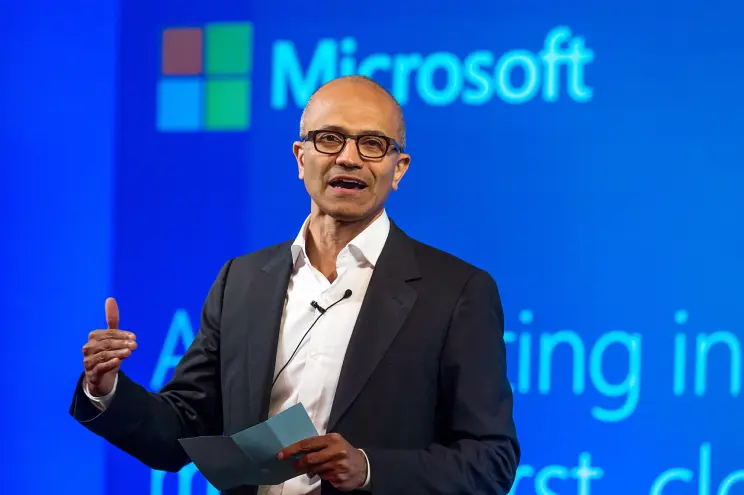Microsoft was a tech giant teetering on the edge of stagnation until Satya Nadella stepped in and reimagined what leadership could look like in the modern era. His empathetic approach and innovative strategies didn’t just revive the company—they turned it into a global leader in technology, inspiring businesses around the world.
In the dynamic and highly competitive world of technology, staying relevant is a challenge even for the most established companies. Microsoft, once the undisputed leader of the tech industry, found itself in a precarious position in the early 2010s. While the company remained profitable, it had developed a reputation for being slow, bureaucratic, and out of touch with the fast-paced changes in the industry. Windows 8 faced widespread criticism, the mobile phone division was floundering, and Microsoft was often perceived as a fading legacy player overshadowed by more agile competitors like Apple, Google, and Amazon.
When Satya Nadella took over as CEO in February 2014, the challenges ahead were monumental. But instead of relying solely on cost-cutting measures or sticking to traditional playbooks, Nadella chose a path less traveled in the tech world—leading with empathy and embracing a culture of collaboration, adaptability, and relentless innovation. This philosophy not only rejuvenated Microsoft’s internal culture but also repositioned the company as a trailblazer in the global tech landscape.
Nadella’s first order of business was to redefine the company’s mission and vision. He famously shifted Microsoft’s focus from a device-centric view to a more customer-centric, cloud-first approach. In his own words, Nadella emphasized that Microsoft’s purpose was no longer about “a world where Windows is at the center.” Instead, the company would strive to empower every person and every organization on the planet to achieve more. This shift in mindset was more than rhetoric—it laid the foundation for a dramatic transformation in Microsoft’s business strategy, operational approach, and product offerings.
One of the most critical moves under Nadella’s leadership was Microsoft’s pivot to cloud computing. Recognizing the growing importance of cloud infrastructure and services, Nadella made Azure a top priority. While Amazon Web Services (AWS) had already established a commanding lead in the space, Microsoft leveraged its enterprise relationships, robust developer tools, and vast global network to carve out a significant market share. Today, Azure is one of the leading cloud platforms in the world, contributing billions of dollars in revenue and playing a central role in Microsoft’s resurgence.
Beyond the cloud, Nadella’s tenure has been marked by a series of bold, forward-thinking decisions that disrupted the status quo. One such decision was Microsoft’s embrace of open-source technology—a radical departure from its historical stance. For decades, Microsoft was seen as the antithesis of open source, but under Nadella, the company made a complete about-face. This culminated in the acquisition of GitHub, the world’s largest repository of open-source code, for $7.5 billion in 2018. This move not only solidified Microsoft’s position as a champion of the developer community but also symbolized the company’s commitment to collaboration and inclusivity.
Another defining aspect of Nadella’s leadership has been his willingness to invest in high-impact acquisitions that align with Microsoft’s long-term vision. The $26 billion purchase of LinkedIn in 2016 brought Microsoft into the heart of professional networking and talent management, while the acquisition of ZeniMax Media and the pending deal for Activision Blizzard have positioned the company as a dominant force in the gaming industry. These acquisitions, while expensive, reflect Nadella’s forward-looking approach to diversifying Microsoft’s revenue streams and staying ahead of industry trends.
Central to all of these initiatives is the cultural shift that Nadella has championed within Microsoft. Under his leadership, the company moved away from the cutthroat, competitive environment that defined its early years and embraced a culture of learning, inclusion, and empathy. Nadella encouraged employees to adopt a growth mindset, valuing curiosity and resilience over rigid expertise. By fostering an environment where employees felt valued and empowered, Microsoft became a place where innovation could thrive organically.
This transformation wasn’t just about internal changes—it extended to how Microsoft interacted with its customers, partners, and the broader tech ecosystem. Nadella’s empathetic leadership style has been evident in his commitment to social impact initiatives, such as Microsoft’s ambitious sustainability goals, its focus on accessibility through technology, and its efforts to bridge the digital divide. Under Nadella, Microsoft has positioned itself not just as a tech leader but as a company with a conscience, dedicated to making a positive impact on the world.
The results speak for themselves. Since Nadella took over, Microsoft’s market capitalization has soared from around $300 billion to over $2 trillion. The company has consistently outperformed market expectations, expanded its influence across multiple industries, and regained its reputation as a leader in innovation. More importantly, Nadella’s tenure has shown that empathy and innovation are not mutually exclusive. In fact, they are complementary forces that, when harnessed effectively, can drive unprecedented growth and transformation.
Microsoft’s resurgence under Satya Nadella holds valuable lessons for leaders, entrepreneurs, and businesses everywhere. It underscores the importance of listening to stakeholders, embracing change, and thinking long-term. It shows that fostering a culture of collaboration and inclusion isn’t just a moral imperative—it’s a strategic advantage. Most of all, it demonstrates that great leadership isn’t about commanding authority—it’s about inspiring people to achieve more together.
Are you ready to take your business or leadership skills to the next level? Stay informed, inspired, and ahead of the curve with Innovation Times. Dive into the latest trends, insights, and success stories in technology, leadership, entrepreneurship, and business.
📩 Sign up now at www.innovationtimes.com to receive daily updates and expert analyses delivered straight to your inbox. Don’t miss the opportunity to learn from industry leaders like Satya Nadella and shape your own success story.


